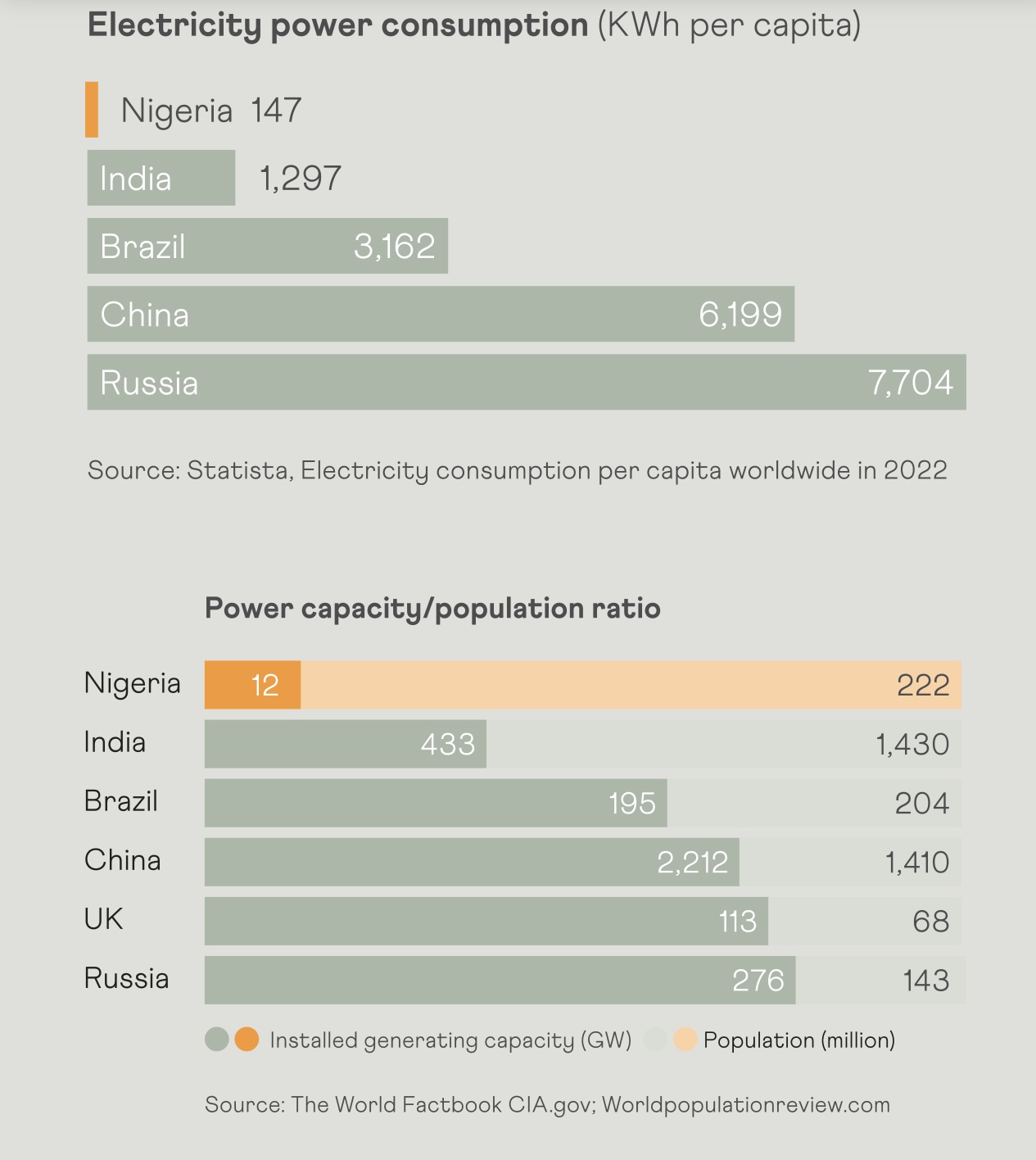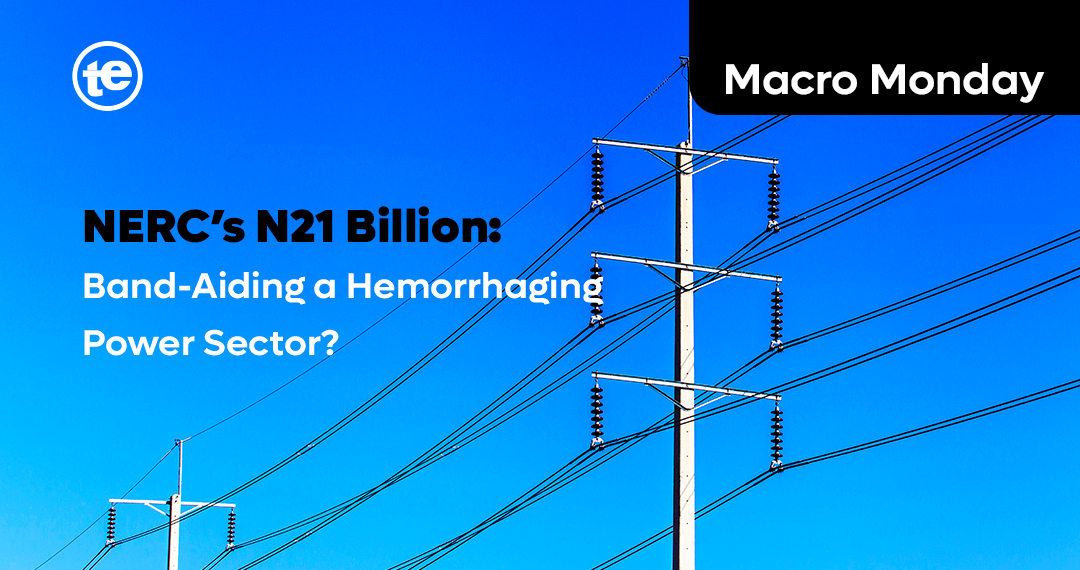The Nigerian Electricity Regulatory Commission’s (NERC) recent approval of N21 billion for metering Band A customers has budded cautious attention, leaving us to wonder if this can truly transform the power sector, or is just a stopgap measure within a crisis.
While metering is essential for accurate billing and handling estimated billing issues, it’s just one piece of a much larger puzzle.
Nigeria’s power sector lives with a lot of interconnected issues including a generation gap, as the country’s current generation capacity is around 13,000MW, falling short of the estimated 30,000MW required for a stable national grid.
Approximately seven million consumers in Nigeria remain without meters. Even the available power struggles to reach consumers, less than 4,500MW is actually being distributed, due to an inadequate transmission network.
According to Statista, in 2022, Nigeria’s electricity consumption per capita was 147 KWh. In comparison, India had a per capita consumption of 1,297 KWh, Brazil 3,162 KWh, China 6,199 KWh, and Russia 7,704 KWh.
Examining the power capacity-to-population ratio, Nigeria had an installed generating capacity of 12 GW for a population of 222 million. India, with an installed generating capacity of 433 GW, served a population of 1.43 billion. Brazil had 195 GW for 204 million people, China had 2,212 GW for 1.41 billion people, the UK had 113 GW for 68 million people, and Russia had 276 GW for a population of 143 million. These figures highlight the significant disparity in electricity generation and consumption between Nigeria and other nations.

In 2023, Nigeria’s national grid could only handle 4,886.40 MW of electricity, as reported by the Nigeria Electricity Supply Industry (NESI). In the first three quarters of 2023, the Nigerian government-subsidized power to the tune of N375.8 billion due to the absence of a cost-reflective tariff.
Power demand in Nigeria is projected to grow by 7% annually from 2024 to 2026, reaching 45,662 MW by 2030. To meet this rising demand, investments are being directed towards gas-fired power generation and renewable energy sources.
Thermal power plants, the mainstay of generation, rely on an unstable gas supply chain impacted by infrastructure limitations and pipeline vandalism.
This lack of accurate billing leads to revenue losses for distribution companies (DisCos) and bigger troubles for consumers.
The NERC’s loan seeks to bridge this gap, with the fund allocation to DisCos being based on their contributions to the Meter Acquisition Fund (MAF) as of the April 2024 market settlement. However, some DisCos have historically underperformed, leaving us to ponder about accountability. The DisCos themselves have lots of debt, hindering investment in infrastructure and maintenance.
N21 Billion: A Drop in the Ocean?
The N21 billion allocation seems good enough at first glance. However, consider this: with an estimated seven million unmetered customers, this translates to roughly N3,000 per meter.
Industry experts assert that smart meter installation, considered ideal for data collection and grid management, can cost upwards of N60,000 per unit. This initial tranche may meter a fraction of Band A customers, leaving the huge majority and the key Band B and C categories (residential consumers) in the dark, literally and figuratively.
Transparency and Accountability
The opaque allocation process for the N21 billion brings further wonders. DisCos with the highest allocations (Ikeja, Abuja, Eko) might not necessarily have the most metering gaps.
The breakdown of the allocation is as follows: Ikeja Electric will receive N4.35 billion, Abuja DisCo N2.99 billion, Eko DisCo N2.92 billion, Enugu DisCo N1.72 billion, Ibadan DisCo N2.51 billion, Jos DisCo N521 million, Kaduna DisCo N1.22 billion, Kano DisCo N1.56 billion, Port Harcourt DisCo N1.36 billion, and Yola DisCo N243 million.
A transparent and data-driven allocation strategy would inspire greater confidence while proper monitoring of DisCo performance in meter deployment and addressing potential misuse of funds are important to ensure this initiative delivers on its promises.
Power Sector Debacle, The Fate Of SMEs
Waiting for the sun to rise before being able to see would be a terrible thing today. However, those who discovered fire realized it could light rooms at night, while those who could afford it used candles. Later, kerosene was used in special lamps. As time passed, illuminating gas provided light in homes and on streets.
Eventually, electricity came along, and now nearly everyone has access to artificial light. Since its invention, humanity has become increasingly dependent on electricity. It is an important form of energy, essential to modern life.
For Africa’s most populous nation, electricity access is a major problem. From households to firms, power seems elusive. According to a report, the electricity grid collapsed 99 times in eight years under President Muhammadu Buhari, with little success recorded in terms of generation and distribution.
Between 2018 and 2023, the Federal Government of Nigeria budgeted N829.788 billion for various electricity infrastructure projects, excluding the $2.3 billion Siemens deal, which failed to deliver the 700 megawatts of power it promised.
As of the second quarter of 2022, only 4.95 million customers were metered, whereas those on estimated billing were estimated at 5.8 million by the National Bureau of Statistics.
According to Ali Bukar Ahmad, the General Manager of Regulation and Compliance at the Transmission Company of Nigeria (TCN), out of an estimated population of 230 million, only 13,112,134 Nigerians are officially registered to use electricity.
We could go on and on, but one thing is clear: there is a direct relationship between a stable electricity supply and the industrialization of any country. The need for electricity in the industrialization of the country is non-negotiable.
According to the Federal Office of Statistics, 97% of all businesses in Nigeria employ fewer than 100 employees, implying that 97% of all companies in Nigeria are “small businesses.” This was also corroborated by the National Bureau of Statistics (NBS), which posited that SMEs contribute 48% of Nigeria’s GDP and employ over 84% of the workforce.
Thus, Small and Medium Scale Enterprises are the backbone of the economy, and anything that affects them threatens the fabric of the entire society.
In the dire straits that the Small and Medium Enterprises find themselves, what is likely to be their fate? Frequent power outages and unreliable supply highly disrupt SME operations, causing production halts, plummeting efficiency, and increased spoilage.
High operational costs arise as SMEs are forced to rely on expensive generators, straining their finances and impacting profitability. Inconsistent electricity hinders expansion plans and innovation, keeping businesses stagnant and reducing their competitiveness compared to those in regions with stable power.
If the power situation remains dire, only SMEs with substantial resources to invest in backup power might survive, leading to a less diverse business industry.
Businesses might adapt by operating at a reduced capacity, hindering overall economic contribution. Additionally, some businesses might relocate to areas with better electricity infrastructure, leading to job losses and missed economic growth opportunities in Nigeria.
SMEs must take practical steps to find solutions, as a longer wait may not bring the desired results. Here are some suggestions:
- SMEs Must Seek Alternative Sources of Energy
While we appreciate the government’s deliberate efforts to address the myriad of challenges in the power sector, the pace at which solutions are coming cannot keep up with the needs of result-oriented entrepreneurs.
Therefore, SMEs should seek alternatives, such as renewable energy, while waiting for the government to fulfill its promises. According to Statista, as of April 2024, Mauritius, Seychelles, Morocco, Tunisia, and Egypt had the most reliable electricity supplies in Africa between 2021 and 2023.
Egypt’s total installed capacity in the power market was 59.5 GW in 2021, expected to grow at a CAGR of more than 2% during 2021-2035, with renewable power growing rapidly but still trailing behind thermal power.
The majority of Egypt’s electricity supply is generated from thermal and hydropower stations. As of 2023, Egypt’s solar energy capacity was 1,856 megawatts, representing a 7.66% increase compared to the previous year. Solar energy accounted for 68.5% of Egypt’s total renewable energy capacity in 2023.
- The Need for an Influx of Private Sector and Entrepreneurs in the Power Sector
There is a belief that the government has no business in business, though some dispute this. Regardless, the government must create an enabling environment for the private sector to thrive.
For example, years ago, one telecommunications company dominated the Nigerian market, exploiting consumers until other providers entered the market.
Today, Nigerians can choose between multiple networks, benefiting from competition. To ensure the strength and efficiency of SMEs, private sectors must be allowed to do business, thereby improving Nigeria’s power sector.
- The Government’s Sincere Approach
Lots of funds have been invested in Nigeria’s power sector, from the defunct NEPA to PHCN and later to GENCOs and DISCOs.
Effective monitoring, sanctions, and recognition of deserving stakeholders are essential. Transparency in this sector is essential.
An entrepreneur like Alhaji Aliko Dangote has led a revolution in the Oil and Gas sector, resulting in the seventh-largest refinery in the world. The government can enhance the power sector, benefiting SMEs and business owners.






